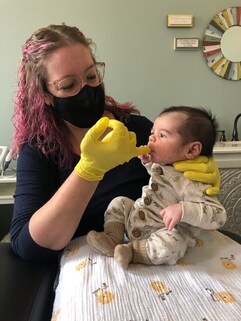|
Birth and breast/chest feeding have been a part of history since the dawn of mammalian existence, bringing various species of mammal together in a profoundly simple, empathetic way. After all, what nursing parent can look upon a nursing lioness without a primal, instinctive understanding of the weariness in her eyes, or give a knowing smile when she pushes an overly rambunctious cub off her nipple after they get too rowdy? The birth and feeding of our young is simply a universal experience across species of mammals throughout the world.
The longevity of our species is due to this process being incredibly efficient and it allows mammals to adapt to a plethora of sub-optimal environments. There is no doubt that the medical establishment has helped our population explode from 1 billion around the year 1800 to almost 8 billion today, just 1200 years later (Worldometer, n.d.), with the evolutionary big bang that is modern western or allopathic medicine. While there is no debate that the rise of allopathic medicine has dramatically improved maternal and infant mortality rates throughout the world, these life phases are never without risk. Due to the inherently vulnerable nature of birthing parents and their children, in 1948 the newly founded United Nations deemed these cohorts have the natural, inalienable right to specialized care and support. The nature of that care and support, however, has not been specified and as a result our species continues to face too many preventable maternal and infant deaths throughout the world. This paper will focus on the United States specifically as a relatively wealthy, developed nation as the challenges in developed nations are quite different than those in developing nations having already successfully overcome many of the challenges that developing nations continue to face regarding access to safe homes, clean water and basic medical care, for example.
2 Comments
When Zeus sought divinity for his son Hercules, born of an adulterous affair with the mortal Alcmene, he sneaked the infant into the bedroom of his sleeping wife, Hera, and put him to her breast for a taste of infinity… Hercules suckled so hard that Hera awoke, and she shook him off in outrage, spurting milk across the skies- hence the Milky Way. Hercules already had swallowed enough, though, to join the ranks of the immortals. Reproductive Justice
It is customary practice for healthcare professionals to obtain consent for treatment from their patients. Of course, this assumes that the professionals deem their patient capable of consent. In the case of obstetricians, many consider the fetus to be their patient at least as equally as the mother. Some states grant rights and protections to the fetus that is denied to the mother in the face of a disagreement or refusal to consent to procedures the healthcare professional deems in the best interest of the fetus, even if there is a risk posed to the mother. Even if the mother does consent to a procedure that puts her at risk, such as a surgical birth called a cesarean or c-section, consent is not as simple to obtain as it may initially appear. The mere fact that a person provides written consent for a medical procedure is not necessarily indicative of an autonomous decision, especially when she may be agreeing to submit to someone in a perceived position of authority such as her physician, or to circumstances beyond her control (Roberts, 1997). Especially in the case of a poor parent or a parent of color, there are certainly plenty of reasons to be wary of causing waves within the medical establishment. The evidence supports this, as discriminatory enforcement of child endangerment laws are well-documented especially among black parents at a rate ten times higher than white parents (Roberts, 1997). In 2004, Melissa Rowland initially refused a cesarean birth for her twins at one hospital, choosing instead to have her cesarean at a different hospital a week and a half later. After one of her fetuses was born a daughter whose blood was positive for both cocaine and alcohol, and the other a stillborn son, the District Attorney’s office charged her under a state statute which established her deceased fetus “as a person for the purposes of criminal prosecution and a theory of conduct evincing a depraved indifference to the value of human life” (Wilde, 2004) and child endangerment. She later accepted a plea deal dropping the homicide charge and pleading guilty to two charges of child endangerment for her use of cocaine during her pregnancy, losing custody of her daughter in the process (Miller, 2005). Eugenics is understood as a movement in the early 20th century intended to improve human heredity. On its face, the movement is a noble one, concerned that public policies to improve the lives of the weakest of our species (which they defined as the mentally ill, disabled, and degenerate) were dramatically influencing the Darwinian evolution of the human race in such a way that might lead to the inferiority of our species. It was on the movement’s influence upon the accepted public discourse and integration within government bodies that led to some of the century’s most heinous legislation, resulting in the loss of bodily choice and integrity for many of our nation’s most marginalized and therefore vulnerable individuals. The very terms segregation and sterilization were originally used in eugenic and bacteriologist literature to mean selective isolation or quarantine and “to eliminate the agents that reproduced disease,” respectively, prior to their use in more recent common vernacular (Pernick, 1997, p. 1769), which implies the original intentions with which these terms were used colloquially. Ellsworth Huntingdon, scientist and one-time president of the board of directors of the American Eugenics society (Text Book History, N.D.), claimed that “America is seriously endangering her future by making fetishes of equality, democracy, and universal education (as quoted in Roberts, 1997, p. 51) by looking to care for our most vulnerable citizens. This paper will show how the aims he sought in these three areas have continued to hold strong through the last hundred years, despite decades of activists’ efforts to the contrary. There are few ways in which our lives are left untouched by way of policy. The most intimate aspects of adult lives are regulated by way of government policy and therefore our level of social privileges. Heterosexism and racism are sanctioned similarly by way of institutional mechanisms used to perpetuate both sexual and racial socioeconomic hierarchies. One such mechanism is the polarization between the binary normal (white, heterosexual, cisgender) and the deviant (person of color, LGBTQ+) that has permeated the public discourse (Nicholson-Crotty, 2005). Another has been the segregation and widening disparities between socioeconomic classes that has given rise to decrepit inner-city ghettos and underrepresented blue-collar communities (mostly filled with people of color) throughout this beautiful country (Collins, 2004).
I propose that degenerative politics are a clear ploy for the age-old villain, the wealthy white man of advanced age who shakes his fists at those “meddling kids,” otherwise known as the rights activists of the times while slyly working the political system to his personal benefit. I’ll show how time and again, political actors engage in these types of binary politics where they are the good guys while the demographic they are targeting (be they African American, poor, female, and/or LGBTQ+) is bad or somehow a threat to the American way of life. They do this to win support from their constituents by uniting them against a commonly perceived threat and also to gain political capitol in terms of alliances with other political actors in the system from within which they work. |
Archives
March 2022
Categories
All
|
HO*LIS*TIC ~ADJECTIVE: Relating to or concerned with complete systems rather than with individual parts
WNY Orofacial & Breastfeeding Support Center is a division of Holistic Parenting Network, LLC, located within the village of East Aurora, NY.
131 Orchard Park Rd. West Seneca, NY 14224 fax: (716) 508-3302 (716) 780-2662 [text friendly]
WNY Orofacial & Breastfeeding Support Center is a division of Holistic Parenting Network, LLC, located within the village of East Aurora, NY.
131 Orchard Park Rd. West Seneca, NY 14224 fax: (716) 508-3302 (716) 780-2662 [text friendly]



 RSS Feed
RSS Feed